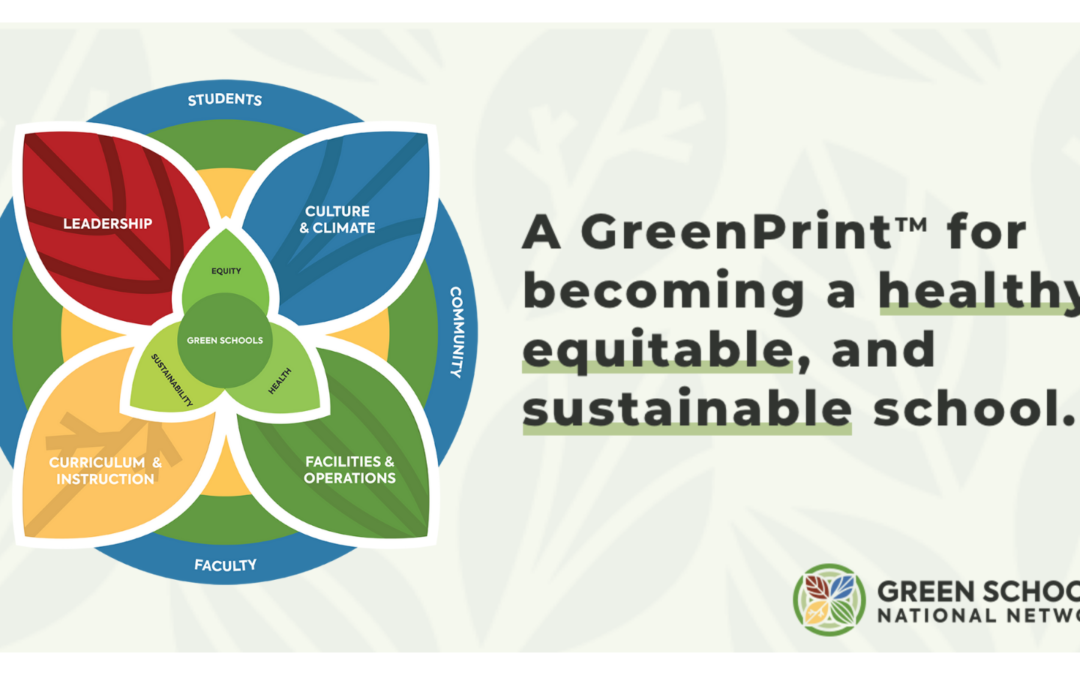The GreenPrint framework serves as an essential tool for holistic K-12 transformation so all students are prepared to live in and lead a sustainable future
IOWA CITY, Iowa, Nov. 15, 2021 — Today, Green Schools National Network (GSNN), a pioneer in the green schools movement, released an updated version of its GreenPrint framework for school and school district leaders. The GreenPrint is a road map for driving purposeful and productive innovation that comprehensively addresses three separate but related spheres of influence: health, equity, and sustainability.
“Green Schools National Network recognizes that the systems change work to create the future we desire needs to be faster and more efficient than ever before,” said GSNN Executive Director Jennifer Seydel, Ph.D. “We are proud of the updated GreenPrint, which underscores that we cannot have a sustainable future without an equitable and healthy space for everyone who works, learns, and plays in our schools.”
After years of conducting research and talking with educators and school leaders who are deeply engaged in the work of implementing green school practices, the updated GreenPrint is grounded in three core beliefs:
- Systemic change endures. GSNN believes healthy, equitable, and sustainable schools can only be achieved through whole-district/whole-school transformation that engages four interdependent systems that define a school: Leadership, Curriculum and Instruction, Culture and Climate, and Facilities and Operations.
- Equity matters. GSNN believes students from all backgrounds and zip codes and regardless of social identities, including gender, sexual orientation, ability, race/ethnicity, and religion/spiritual beliefs, should have an equitable opportunity for academic success and equitable access to healthy environments.
- Everyone is a leader and a learner. While leadership is key to creating healthy, equitable, and sustainable schools, every member of the school community – staff, students, parents, and community members – has a voice and a hand in creating systems and opportunities that increase engagement, deepen learning, and build the confidence and competence needed to become agents of change for a just and sustainable future.
Additionally, the framework addresses four impact systems that power the levers of change. In any school or district, interaction of these systems – Leadership, Curriculum and Instruction, Culture and Climate, and Facilities and Operations – is necessary to optimize the health of
the whole district and its schools and accelerate progress toward strategic goals.
- Leadership is responsible for communicating the vision, creating policy, establishing budgets, and holding others accountable for implementing what is said or written. Teachers, community members, and even students can lead initiatives. In this GreenPrint, however, leaders typically refers to administrative leaders at the district or school level, or to staff who serve in an administrative capacity for a department or division.
- Curriculum and Instruction reflects what is taught and how. It includes the design or adoption of particular curricula, instructional philosophy and methods, professional learning, and the structures designed to sustain learning for all students over time.
- Culture and Climate shapes and influences behaviors and mindsets within the school community. Culture is defined by the core beliefs of leaders, teachers, students, and other members of the school community. Climate is defined by the actions that demonstrate those beliefs.
- Facilities and Operations is responsible for the practices, actions, and processes used to purchase, design, build, and maintain the physical spaces and resources needed to operate healthy, equitable, and sustainable schools. Facilities and operations also influence how buildings impact the health and well-being of members of the school community who use those spaces.
“Our goal was clear – to create a new and comprehensive GreenPrint that would ensure schools and school districts could provide students from all backgrounds and zip codes, regardless of social, gender, or racial identity, an equitable opportunity for academic success and equitable access to healthy environments,” said GSNN Board Member and Director of Educational Partnerships Timothy Baird.




